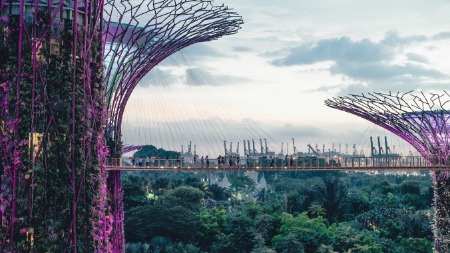News - November 17, 2020
Towards Sustainable Air Travel: Challenges and Opportunities


Written by Expert: Dr Astéris Apostolidis
Dr Asteris Apostolidis is an Expert with the Solar Impulse Foundation. He works for Air France-KLM in the area of Technology Innovation Management, as a member of the Group Strategy Technology Office. His scientific interests include Artificial Intelligence in Aeronautical Systems, Sustainability in Air Transport, Innovative Aeronautical Architectures, Aviation MRO and Strategy Development & Execution. In this Technical Article, Asteris sets out why sustainability in aviation has never been more important, and what action can be taken in the sector.
It is undoubtable that the ongoing COVID-19 pandemic has a dominant impact on our collective and personal welfare. At this point, the global economy is in decline, while many of us re-evaluated various aspects of our own lives. Air transport is one of the most impacted industries for many reasons. Predominantly, all the imposed travel restrictions have an adverse effect in passenger traffic, which brought most airlines beyond their limits.
In this context, it could be reasonable for the air transportation sector to emphasise on short-term survival and step back from prioritising environmental sustainability. However, with air traffic virtually halted, the impact of flying to the environment became even more evident. With oil prices tumbling since early March to a record-breaking collapse, Jeffrey Currie, head of commodities at Goldman Sachs, told The Guardian newspaper that the fallout of the pandemic will likely “permanently alter the energy industry” and “shift the debate around climate change”. As most airlines deployed various transformation programmes to cope with the crisis, a rare opportunity arose, especially in Europe. Many of these transformation plans included important elements on sustainability for air travel. Indeed, some airlines and aircraft manufacturers started working on green transformation way before the pandemic. However, these plans seem to have been accelerated. There are many possible explanations why, but it can be mainly attributed to the increased environmental awareness of their customer base, the strategic decision of the European Union to proceed with the European Green Deal and the increasing sense of corporate social responsibility among airline executives and employees.
The coronavirus pandemic is a telling example of how a global crisis looks like. Nevertheless, the main difference with climate emergency is that the former was unforeseeable, whereas there are countless warnings for the latter. It would be irresponsible to ignore them and renounce the responsibility of airlines in addressing them. Experience so far identified three main technical pillars that can lead air travel into a more sustainable future: Improved operational efficiency, disruptive aircraft architectures and multimodality.
Improved operational efficiency is possible to be achieved in the short- and mid-term with a greater use of Artificial Intelligence: It is a common practice nowadays for airlines to use data-driven methods in various operational domains. For example, improved fuel efficiency can be accomplished by analysing hidden patterns in flight data and streamline the way aircraft are operated. Another interesting possibility is to enhance the use of operational data in order to improve the maintenance practices for engines, airframes and other aircraft components. This way, data science has the potential to improve the life cycle of parts, resulting in less waste in usually very expensive material. At the same time, maintenance planning can make use of historical data to identify the optimal point in time for the overhaul of hardware, which also generally leads to improved fuel consumption. Overall, AI has the potential to bring some step changes in the way aircraft are designed, operated and maintained. However, as aviation is a strictly regulated domain due to safety considerations, a main impediment is the lack of certification procedures for safety-critical AI-based applications. Nevertheless, there are currently industry-wide efforts to develop the necessary standards that will turn Artificial Intelligence certifiable in aviation.
Looking a bit further into the future, one will see a plethora of new and very interesting aircraft technologies that can change the way we fly for good. New engine layouts promise increased thermal performance, with undoubted positive environmental effects. At the same time, there is a coordinated global effort to develop the necessary technologies that will enable a sharp increase in the production of Sustainable Aviation Fuel (SAF). There are many ways to produce SAF, but ethical production makes use of different types of waste, such as cooking oil and this is the reason why current production is fairly limited. In addition to that, a new generation of disruptive aircraft layouts envisions the use of hydrogen as aviation fuel, either directly combusted in engines or in combination with fuel cells. Other interesting possibilities are battery-based electric or hybrid-electric aircraft, which have operational limits nonetheless. Last, there are numerous examples of innovation in aerodynamics, with different proposals for futuristic aircraft designs. All the aforementioned technologies are currently in different stages of development, with the most mature ones expected to be deployed somewhere at the end of this decade. However, again safety considerations are very important for the success of these solutions, along with a necessary transformation of the -very complex- supply chain. It is certain that all new technologies also imply numerous operational challenges as well.
The third, promising tool in tackling the environmental impact of aviation is the further development of multimodal transportation. Multimodality makes use of different modes of mobility, in order to offer the best option to passengers from an environmental standpoint. An example is the seamless combination of air and rail transport, where a passenger can combine both in one ticket. By doing so, one can make use of a long haul flight and a train ride for the last part of their trip, avoiding unnecessary regional flying. At the same time, multimodality can open a new business model, where connections do not take planes only at major hubs, but also in smaller airports with rail connections. This solution poses a number of risks regarding the current, established business practices, but it can also lead in wider partnerships. In the future, apart from the combination between air and rail travel, other modes of transport might become part of this model. For example, Hyperloop or eVTOL (also known as Urban Air Mobility) have the potential to offer a sustainable ‘first and last mile’ to passengers.
Something worth mentioning is that the time frame for the introduction of the above three main pillars will not be the same around the globe; it depends on a mix of geopolitics, investments, government emission targets and, of course, consumer behaviour. However, it looks that Europe will be a pioneer in this context. To put things into perspective, it is also important to mention that before the pandemic 72% of transportation greenhouse gas emissions in Europe were due to road transport, compared to 14% for air transport, according to the European Environmental Agency. Consequently, the decarbonisation of roads is an even higher priority for policymakers.
Air travel fundamentally serves the society by bringing people together and supporting the circulation of goods. This is also the case during the ongoing pandemic, when airlines transported the global circulation of supplies and they are expected to contribute to the distribution of the vaccines, once they start being produced. However, an improved resilience of the industry is paramount with climate emergency on the horizon. The social mission of air travel is widely acknowledged and its future relies on how air transport will adapt to these new challenges.

Written by Expert: Dr Astéris Apostolidis on November 17, 2020


